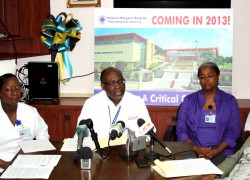
Nearly a month after two babies died following a bacterial outbreak at the Princess Margaret Hospital (PMH) and officials still cannot explain how the water-bourne illness started.
Addressing reporters on the Acinetobacter Baumannii outbreak yesterday, PMH Medical Chief of Staff, Dr. Geoffrey Pennerman acknowledged that each time this type of illness occurs doctors are stumped.
“I’m sorry to say at this point in time we can’t say with any certainty how this started,” he said.
“We know we’ve got it. We tested the air conditioning systems for it, we thought that there was some suspicious activity on the coils, but we are still awaiting information on the ward concerned.”
According to the medical chief of staff, continued screening has revealed that five infants are colonized, meaning that the bacterium is still present in certain areas of their body and that they are no longer critically ill, but are still infected and stable.
“We get infections in babies and adults all the time and we deal with them the way we are trained to,” Dr. Pennerman said.
However, hospital officials yesterday admitted that the two babies who died as a result of the outbreak were dead for up to three weeks before it was made public.
One of them died on July 4 and the other on July 17.
An outbreak was not declared until July 18, nine days before a press release was issued on July 27.
Dr. Pennerman could not say why it took so long for the information to be disseminated.
“I can’t give you a specific reason. The practice in the hospital is if we have this sort of thing, communication is to be made to our corporate office, so that they know about what is happening,” he said.
“In terms of alerting the public this is not something that is routinely done. We are obliged as practioners to certainly alert the chief medical officer (CMO) of the country if we have an infection that is called a notifiable disease. The law says you must notify the CMO if you have disease ‘A’ ‘B’ or ‘C.’ This was not a notifiable disease like that. But the standard practice was adhered to.”
According to reports, Ministry of Health officials “received the information late” from hospital authorities.
Dr. Pennerman added that the first baby was infected at the end of June and the second one a couple days after.
He said all the babies were less than three weeks old at time they contracted the infection, adding that they were all born up to 16 weeks too early with none of them developing any defense system by the time they were born.
The last time there was an outbreak of this particular bacterium at PMH was nearly 16 years ago, according to hospital officials.
Health Minister Dr. Perry Gomez explained to the Bahama Journal on Monday that the infection is common to hospital and related institutions.
“It’s a water-loving organism and so it’s associated with water and dampness. You may isolate it from ventilators or air-conditioning vents and tubing or anywhere there is moisture,” he said.
“It’s a hospital organism, so it’s something that falls under the category of what’s called nosocomial infections, that’s hospital acquired infections and that’s an issue in hospitals all around the world.”
Meantime, doctors have assured that they are continuously working to contain and rid the ward of the bacteria.
According to Dr. Pennerman, they have been in talks with the parents of all families of the infected babies, adding that the Infection Control Unit has examined all clinical procedures to ensure compliance by all persons providing care.
“Adherence to strict infection control practices as it relates to hand washing, decontamination and environmental control practices,” he added.
“Re-training has occurred in all grades of staff and is ongoing. The Infection Control Unit continues its normal surveillance activities.”
Ongoing investigations continue, which include talks with officials of Pan American Health Organisation (PAHO).



This is absolutely terrifying, but I’m glad it was reported. The public needs to know about these type of things.